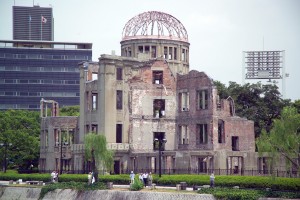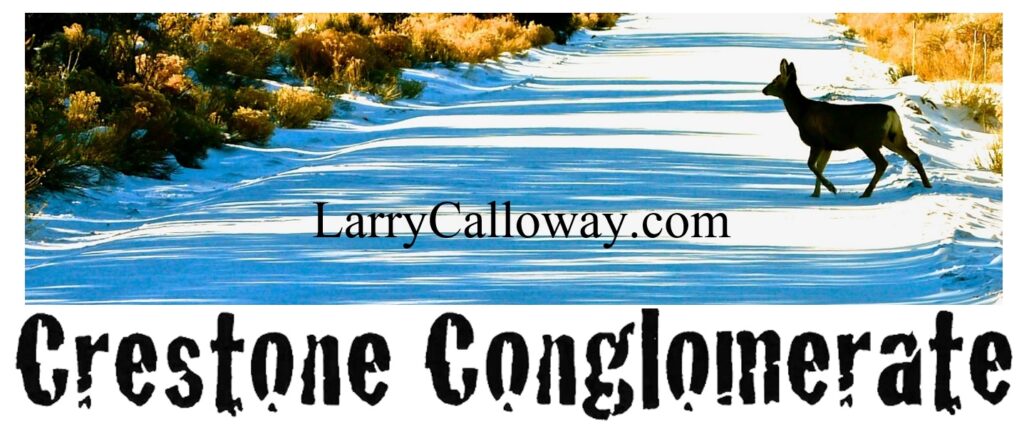
(Note: I re-posted this for the 65th anniversary. It was written five years ago.)
I went up to Shumei for their monthly sampai the other day – it was Sunday morning, that’s all I knew. There are days in these strange Sangre de Cristo Mountains when without warning I am felled by subtle meaning.
Shumei is an international spiritual association based in Japan. Daily services in the high curved-wood sanctuary at the Shumei Crestone International Institute involve prayers of gratitude and spiritual healing. The monthly sampai, a service for the community at large, often is followed by a slide show. I have seen some good ones at these sessions – about adventures in Shumei’s work for chemical-free agriculture, about a trip to its sanctuary and art museum in the mountains near Kyoto.
On this Sunday the closing “Jyorei,” a form of healing meditation practiced at Shumei, was unusually intense, it seemed to me, because of the presence of a large number of teenagers on a short summer visit from Japan. They seemed so pure and powerful in their spirit. Then the new Sensei (respected leader) took up the wireless microphone by the digital projector and the Apple laptop. The first slide he clicked on the big screen was a faded shot of the museum at Peace Park in the middle of Hiroshima. The second was a pair of old black-and-white photographs of a shadow on a granite step.
There the sequence stopped. He began to explain. I already knew.
The first thing in the sequence of phenomena in an atomic explosion – as I often reviewed but did not report in my stories on anniversaries of the Trinity test of the Los Alamos bomb – is a blinding flash of light, brighter than “a thousand suns.” The permanent shadow on the step of the Hiroshima bank building was cast at 8:15 a.m., Aug. 6, 1945, by a person sitting there, probably waiting for the bank to open. He (or she) was, the story goes, vaporized in an instant. Only the shadow remained.
Sensei let this sink in. He recalled being in a sudden emergency on an airliner and reaching for a pen and paper to write a final word of love to his wife and children. The unknown on the bank step near Ground Zero (as the Americans called it) had no time to prepare for death. The Sensei wondered if anyone had anything to say. Silence. Even the energetic teenagers were still.
Rosalind, a gentle woman who is close to Shumei and helps its new staffers with English, spoke up. There had been a demonstration at Los Alamos, south of here, on Aug. 6. It was the 60th anniversary. Others spoke of other protests. I wondered if I should say something. I had been to Hiroshima with a group of 12 mid-career journalists studying for a year at Stanford in 1980. . . .
I had seen the ghostly shadow. There were others. John Hersey called attention to them in his courageous report, published in the New Yorker on the first anniversary of the bomb (when Americans were still animated by war psychology). These shadows were among the data Japanese scientists used to triangulate Ground Zero and the elevation of the burst.
Hersey reported that the imprints inspired woefully embellished stories of final immeasurable instants of life: a painter on a ladder about to dip his brush, projected on a wall, a driver in a cart about to whip his horse, projected on the deck of a bridge.
The second phenomenon in an atomic blast, I recalled, is the shock wave. It blew away the skin of the dome of the Commerce and Industry building, leaving the structural steel intact. My seventh grade home-room teacher, Miss Elfstrom, upset us teenagers (and some parents) with a slide show of her trip to Hiroshima, the center of which in those days was the skeletal dome. It eventually became a symbol, and when I finally saw it as an adult in 1980, I was drawn to it. I walked across Peace Park that evening after we had checked in at our luxurious skyscraper hotel. I wanted to see how the grounds around the famous dome were landscaped, to read the words on the memorial plaques.
There was nothing. The ruin had been left unaltered for 35 years. It was surrounded by a steel fence. Inside the fence was rubble and weeds. Zen, I thought.
The third phenomenon in an atomic blast is heat, memorialized then at the Hiroshima museum in a collection of melted things – a folded bottle, a surreal radio, a twisted tricycle – and in the diorama of a mother trying to shelter her children as her cooked skin fell away. Hersey brought these terrifying stories to an American public that did not want to hear them. But by the time they were related with subtle understatement in the French film “Hiroshima, Mon Amour” a decade later, the word Hiroshima was all that needed to be said, anywhere in the world. (Emmanuel Riva, in despair, sits alone in the train station. The loudspeaker repeats: Hiroshima, Hiroshima, Hiroshima.)
Behind the pheonomena was the invisible killer, radiation. Many who were not crushed or immolated died within hours from unseen causes. Two weeks later, many who seemed to have escaped injury became lethargic. Minor scratches became festering wounds, Hersey reported. Some died then, others in months, or even years. In 1955, Sadako Sasaki, a survivor who was two years old when the bomb fell, developed leukemia attributed to radiation exposure. In keeping with a folk tradition that those who fold a thousand paper cranes will be granted their wishes, she folded cranes and wished to live. She died. School children began folding paper cranes in her memory as a collective wish for world peace. There is a memorial to Sadako at Peace Park – a huge hollowed bomb casing sheltering strings of paper cranes, replenished constantly.
I recalled how our guide then, an employee of the Liberal Democratic Party, argued quite soberly that the fanatical military government should be blamed for getting Japan into so much trouble and bringing on so much suffering and death in the world. (She did not include Emperor Hirohito in her indictment.) But I recalled one evening in a bar she said, “To go to Hiroshima is to cry,” and she did not accompany us to Peace Park that day.
I recalled how we bought some flowers and placed them at the cenotaph at Ground Zero. There is a stone coffin there containing the names of the dead. It is opened annually on Aug. 6 for new names. The total now is a little over 242,000. The cover sheltering the monument is modeled after an ancient Japanese burial artifact, but it looked to me like the canopy of a covered wagon heading westward in accordance with Manifest Destiny. I recalled a translation of the words on the cenotaph. . . .
Suddenly, a gravely old voice from the back of the sanctuary: “On the day the bomb was dropped I was a Marine on Guam. . . ”
Wait, I thought, not here, not now. In my reporting over the years I had heard that kind of lead-in too many times to count. It was invariably followed by, “and. . . the bomb saved my life. . . saved the lives of a half million troops. . . even saved millions of Japanese who were dug in to fight to the death. . . ” or words to that effect.
I turned and saw this was Hob speaking. He is about 80, a writer on salvation from drugs and alcohol, who stopped drinking 40 years ago. “I was a Marine on Guam, and,” he was saying. “And I was sorry. And that is one reason I came to Crestone. And I love you all.” The old voice cracked.
Silence. Then, spontaneously, I spoke, had to speak. I don’t remember what I said. Something about the flowers at the cenotaph and how we journalists were photographed and put on Hiroshima television that night because, apparently, even in 1980 this was an unusual gesture by American visitors to Ground Zero. I said something about how in all my reporting about Los Alamos I had never met a scientist who had been to Hiroshima, or wanted to go there.
I did not confess that I, like the scientists, compartmentalized, keeping the story of the development of the bomb separate from its use, reasoning that this was an appropriate telling of the story because it was the way the scientists thought. It was, after all, wartime. See, they did not make the decision to use the atomic bomb, feared that Hitler too was developing it, had no reason to know it would be used on civilians in Japan, were objective men of science doing their job of inevitible discovery, and so forth.
Finally, although I knew, I asked Sensei if anyone could translate the words on the cenotaph. A spirited discussion ensued, in Japanese. The teenagers were responding, several of them. They knew. They seemed to reach a consensus, and the Sensei said in English: “You can sleep well because this terrible mistake will not be repeated.”
Yes. Rest in peace. It will not happen again.
After the monthly event at Shumei there is a light lunch in the dining hall. As I approached the food table – the chemical-free products of “natural agriculture”– a strange thing happened. I was surrounded by teenagers, all girls. So curious. So precocious. So bright.
“We are from Hiroshima,” one said.
Her name was Momoko. She was 13. She and some of her friends sat with me at lunch.
“Talk to us,” several said. I took this to mean they wanted to practice their English. The language barrier was very high. One asked my age, and they were all interested in my reply: very old, they seemed to agree among themselves, doing the math. I asked about their schooling and how many traditional characters they could draw. Momoko said they knew about 1,000.
One of them disappeared and came back with six paper cranes, which she dropped on the table. Another said, for no apparent reason, that she had been to New York City, but I could not follow her meaning.
Momoko translated: “She had a funny feeling. Same, Peace Park.” She made a motion indicating nausea.
“She went to Ground Zero – the Twin Towers?”
“Yes.”
When it was time to go, Momoko asked if she could take my picture. She and some of the other girls gathered around me as a Shumei staffer clicked Momoko’s Olympus, and she then had me write my address. We all said goodbye. Typical tourist behavior, I thought.
And maybe it was. But that night I got to googling “Hiroshima.” In Japan, I learned, it was the 60th anniversary of the surrender ending World War II, and Junichiro Koizumi was making an apology, which politicians in China and Korea were rejecting as inadequate. War psychology, reloading. . .
Did the teenagers in the sanctuary care? It occurred to me that they did. They were from Hiroshima.
“Jesus H. Christ,” I thought. “I wasn’t ready for this! I didn’t need this, or, didn’t KNOW I needed this. I think I have just been forgiven.”
(For the Los Alamos path to Hiroshima, see this)
To comment, first hit the headline. . .
